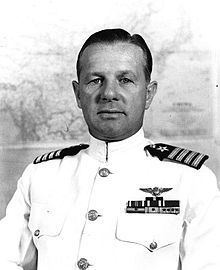Nickname(s) Wade Name C. McClusky | Years of service 1926–1956 Allegiance United States | |
 | ||
Born June 1, 1902Buffalo, New York ( 1902-06-01 ) Commands held VF-6Enterprise Air GroupUSS Corregidor (CVE-58)NAS Glenview Battles/wars World War IIBattle of Midway Died June 27, 1976, Orange, Virginia, United States Battles and wars | ||
Rear Admiral Clarence Wade McClusky, Jr., (1 June 1902 – 27 June 1976) was a United States Navy aviator during World War II. He is credited with playing a major part in the Battle of Midway. In the words of Admiral Chester Nimitz, McClusky's decision to continue the search for the enemy and his judgment as to where the enemy might be found, "decided the fate of our carrier task force and our forces at Midway...".
Contents
Naval aviator and instructor
C. Wade McClusky, Jr. was born in Buffalo, New York, on 1 June 1902. He graduated from the United States Naval Academy in 1926, the same class as Max Leslie, and became a Naval Aviator three years later. Over the next decade, he served in several air units, as well as on command staffs, as an instructor at the Naval Academy and at shore facilities. In 1940 he was assigned to Fighting Squadron Six (VF-6), based on USS Enterprise, and assumed command of that squadron in April 1941.
Battle of Midway
Lieutenant Commander McClusky became Enterprise air group commander in April 1942. During the Battle of Midway, while leading his air group's scout bombers on 4 June 1942, he made the critical tactical decision that led to the sinking of two of Japan's fleet carriers, Kaga, and Akagi. When McClusky could not find the Japanese carriers where he expected them, and with his air group's fuel running dangerously low, he spotted the Japanese destroyer Arashi steaming north at flank speed. (The Arashi had stayed behind to attack the submarine USS Nautilus, which had been harassing the Japanese fleet.) Surmising that the Arashi must be following the main fleet, McClusky ordered a change in course to follow the Arashi. This led him directly to the enemy carriers. He then directed his dive-bombers into an attack which led to the destruction of both Kaga and Akagi. A squadron from the Yorktown, led by Max Leslie, had taken off an hour later, but it used a more recent, and hence more accurate, sighting for the location of the Japanese carriers. It arrived at the same moment as the Enterprise's bombers and attacked the Soryu, and within minutes, three of the four Japanese carriers had been turned into burning hulks. McClusky, through his intelligence, courage and sheer luck, had thus made a vital contribution to the outcome of this pivotal battle. For his actions, which turn the tide in the battle, McClusky was awarded the Navy Cross. Later in World War II, he commanded the escort carrier USS Corregidor.
After the war
Captain McClusky served in a variety of staff and shore positions in the later 1940s. During the Korean War, he was Chief of Staff to the Commanders of the First and Seventh Fleets. He commanded Naval Air Station Glenview, Illinois, in 1952–53, and the Boston Group of the Atlantic Reserve Fleet in 1954–56. McClusky retired from active duty in July 1956. At that time, in recognition of his vital contributions to the outcome of World War II, he was advanced to flag rank.
Namesakes
USS McClusky (FFG-41) was named in his honor. The Wade McClusky Award is given annually to the most outstanding attack squadron in the US Navy.
